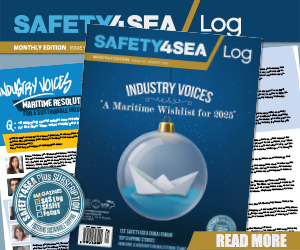During the 2024 SAFETY4SEA Athens Forum, Jacob Damgaard, Head of Loss Prevention, Britannia P&I Club, explored the essential elements of an effective safety culture and how organizations can cultivate it.
What is an effective safety culture?
The simplest way of defining safety culture is describing it as “the way we do things around here”. As part of organisational culture, safety culture is a product of beliefs, perceptions and values related to safety, shared by all members of the organisation.
Safety culture, as part of an organisational culture, is a driving force which permeates every aspect of an organisation. Together with leadership and safety management, they form the fabric of safety. The influence of safety culture on safety may be as big as the SMS itself. A broken safety culture can undermine even the best policy or procedure.
A typical Safety Management System (SMS) consists of policies, procedures, checklists etc. However, safety cannot be created solely by setting up and following procedures. To achieve safety, you need also a good safety culture supported by strong safety leadership. Furthermore, a successful green transition requires safety at the forefront.
Key elements of effective safety culture
- Leadership commitment
- Open communication
- Crew empowerment and participation
- Accountability and responsibility
- Positive reinforcement
- Just culture
- Physical and mental well-being
Green KPI’s or Red Flags?
We often hear about KPIs, with many claiming they have a great safety culture because their Lost Time Injury (LTI) rates are low. While that might seem impressive, my experience as a surveyor and auditor tells me that if your KPIs are all green, that can actually be a red flag for me. Low number of incidents can sometimes indicate a poor safety culture and a lack of reporting.
What is safety leadership?
Many people in the industry feel they lack empowerment and are required to follow top-down directives. This can be challenging, especially since officers can’t be everywhere at once. Safety culture needs to flow both ways, not just from the top down.
Leaders are people who influence the behaviours and attitudes of others. A useful definition of a safety leader was provided by ConocoPhillips in one of their training programmes:
“A safety leader is a person who cares enough to take the action to keep themselves and others free from danger or injury through guidance, persuasion, direction and/or setting the example.”
Safety leaders can exist at all levels of a shipping company, from senior executives and board members, to superintendents, masters, officers, and other crew members. Any individual in an organisation can be a safety leader. Safety leaders and managers are not necessarily the same people.
Managers exert formal influence on their subordinates as part of an organisation’s structure. Leaders exert a social influence over co-workers by setting an example. One can be both a manager and a leader, but this can only really happen when they are conscious about effectively performing both roles.
Safety leaders motivate people through engagement and participation. They also help maintain a just culture which is key to a genuine safety partnership. Safety is both a partnership and a social activity, where everyone must work as a team to achieve success.
How to achieve effective safety leadership?
Soft skills like empathy and cross-cultural understanding are vital, especially in the multicultural environment of shipping. Crew members come from diverse backgrounds—Filipinos, Indians, Greeks, and more—each with their own preferences and motivations. As a soft skill, encouraging effective safety leadership requires a different approach to the promotion of effective safety management.
Positional leaders tend to act from a position of authority and tell people what they want them to do. Inspirational leaders motivate people by appealing to their values and aspirations. They create a shared vision of safety which resonates more deeply with team members and inspires them to achieve the safety goals willingly.
Depending on the situation, it is possible to develop an effective combination of positional and inspirational leadership in safety.
The UK MCA (Maritime and Coastguard Agency) has developed guidance to safety leaders, available online, which is continually updated. The guidance identified core safety leadership qualities, which belong to the following categories:
- Confidence and authority – Examples: earning respect through the leader’s actions, leading by example, drawing on knowledge and experience, remaining calm in a crisis.
- Empathy and understanding – Examples: practising ‘tough empathy’, cultural sensitivity, recognising people’s limitations.
- Motivation and commitment – Examples: creating a sense of community, encouraging communication and feedback regarding safety, caring for crew welfare issues, placing safety above all other matters, commitment to addressing root causes of safety issues.
- Openness and clarity – Examples: active listening, open door policy, general atmosphere of openness.
Fortunately, we are also now seeing more women at sea, which brings a fresh perspective. In the past, the workforce was predominantly male, and soft skills were not prioritized.
Safety is a partnership; it requires collaboration, and the type of leadership in place can make a significant difference. Viewing safety as a partnership results from the shared ownership of safety and requires a mutual respect and trust.
This why we need both positional and inspirational leaders. The positional leader is the one who tells you what to do—like directing you to paint the deck. On the other hand, the inspirational leader motivates and engages the team.
While many people emphasize the importance of inspirational leaders, it’s essential to find a balance eventually.
Empowering seafarers
While shipping is becoming more complex and some oversight is necessary, the level of micromanagement seems to be rising. This can impact crew retention.
Ultimately, what keeps me up at night is the empowerment of seafarers. It affects their safety, mental well-being, and how long they choose to stay at sea. When crew members feel empowered, their mental and physical well-being improves, leading to better feedback and reporting.
Honest feedback is essential for a healthy culture; you can’t make improvements without it. Crew members need to feel comfortable sharing their concerns. Stop Work Authority is an example of how seafarer empowerment may improve safety. This technique provides all personnel with the authority (and obligation) to stop work in case of a perceived unsafe condition or behaviour. This adds a very effective safety barrier.
As a key takeaway, empowering seafarers enhances maritime safety by better enabling their skills and motivation to act responsibly and decisively in both routine operations and emergencies. This reduces risks, improves compliance with safety regulations, and fosters a proactive approach to safety onboard. Furthermore, as decarbonization continues to be a significant focus in our industry, it’s more important than ever to prioritize their well-being.
Above article has been edited from Jacob Damgaard’s presentation during the 2024 SAFETY4SEA Athens Forum.
Explore more by watching his video presentation here below
The views presented are only those of the authors and do not necessarily reflect those of SAFETY4SEA and are for information sharing and discussion purposes only.































































